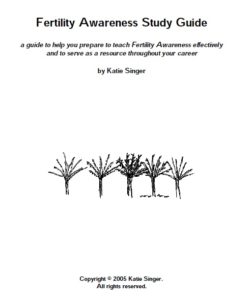TEACHING FERTILITY AWARENESS
Katie Singer’s Study Guide for Teaching Fertility Awareness is available through PayPal for $35.00. The guide includes about 300 questions and a bibliography designed to help you prepare to teach Fertility Awareness effectively and to serve as a resource throughout your career.
 Fertility Awareness Teacher Study Guide
Fertility Awareness Teacher Study Guide
57 pages, online .pdf file, 3.82 MB
(downloadable, printable)
$35.00
Please allow 48 hours for us to email you the Study Guide.
To teach the method effectively, you need:
- to chart your own cycles for at least 18 months;
- to read about Fertility Awareness extensively (see Bibliography in the Study Guide);
- to attend at least two classes taught by other FA and NFP teachers;
- ability to interpret ‘non-textbook’ charts;
- resources for strengthening menstrual cycle health;
- to know when a client needs to see a physician;
- to help women talk with their doctors–who are typically untrained in Fertility Awareness;
- to support women who remember sexual trauma, unintended pregnancy, miscarriage and other emotionally challenging experiences while they begin charting;
- tutorials with a senior teacher; and
- review of class handouts by a senior teacher with editorial skills.
You should also complete the Study Guide and have it reviewed by a senior teacher.
When you are ready to have your completed Study Guide reviewed by a senior teacher, please contact the Fertility Awareness Network in New York (212.475.4490). Please note that review of this study guide will require paying the teacher for her time; and completion of it does not necessarily lead to certification.
FERTILITY AWARENESS STUDY GUIDE – TABLE OF CONTENTS
Section One: History, Politics & Effectiveness
Section Two: Anatomy & Physiology
Section Three: The Hormones
Section Four: Cervical Fluid
Section Five: Basal Body Temperature (BBT)
Section Six: Male Anatomy
Section Seven: Rules for Preventing Pregnancy
Section Eight: Special Circumstances
Anovulation
After the Pill
Breastfeeding
Menopause
Other Special Circumstances & Questions
Section Nine: Using Charts as an Introductory Gauge of Gyn & Overall Health
Section Ten: Teaching
Section Eleven: Charts
Bibliography